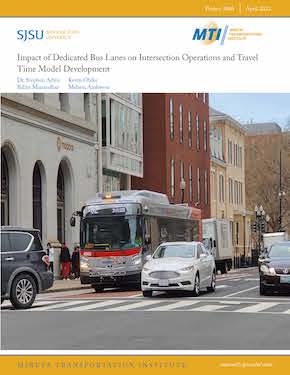- 408-924-7560
- mineta-institute@sjsu.edu
- Donate
Impact of Dedicated Bus Lanes on Intersection Operations and Travel Time Model Development
Over the years, public transit agencies have been trying to improve their operations by continuously evaluating best practices to better serve patrons. Washington Metropolitan Area Transit Authority (WMATA) oversees the transit bus operations in the Washington Metropolitan Area (District of Columbia, some parts of Maryland and Virginia). One practice attempted by WMATA to improve bus travel time and transit reliability has been the implementation of designated bus lanes (DBLs). The District Department of Transportation (DDOT) implemented a bus priority program on selected corridors in the District of Columbia leading to the installation of red-painted DBLs on corridors of H Street, NW, and I Street, NW. This study evaluates the impacts on the performance of transit buses along with the general traffic performance at intersections on corridors with DBLs installed in Washington, DC by using a “before” and “after” approach. The team utilized non-intrusive video data to perform vehicular turning movement counts to assess the traffic flow and delays (measures of effectiveness) with a traffic simulation software. Furthermore, the team analyzed the Automatic Vehicle Locator (AVL) data provided by WMATA for buses operating on the study segments to evaluate bus travel time. The statistical analysis showed that the vehicles traveling on H Street and I Street (NW) experienced significantly lower delays during both AM (7:00–9:30 AM) and PM (4:00–6:30 PM) peak hours after the installation of bus lanes. The approximation error metrics (normalized squared errors) for the testing dataset was 0.97, indicating that the model was predicting bus travel times based on unknown data with great accuracy. WMATA can apply this research to other segments with busy bus schedules and multiple routes to evaluate the need for DBLs. Neural network models can also be used to approximate bus travel times on segments by simulating scenarios with DBLs to obtain accurate bus travel times. Such implementation could not only improve WMATA’s bus service and reliability but also alleviate general traffic delays.
DR. STEPHEN ARHIN, PE, PTOE, PMP, CRA, F. ITE
Dr. Arhin is an Associate Professor and the Interim Chair of the Department of Civil and Environmental Engineering of Howard University, the director of the Howard University Transportation Research and Traffic Safety Data Center (HUTRC), and the director of this transit research project, conducted under the Mineta Consortium for Transportation Mobility.
-
Contact Us
San José State University One Washington Square, San Jose, CA 95192 Phone: 408-924-7560 Email: mineta-institute@sjsu.edu






